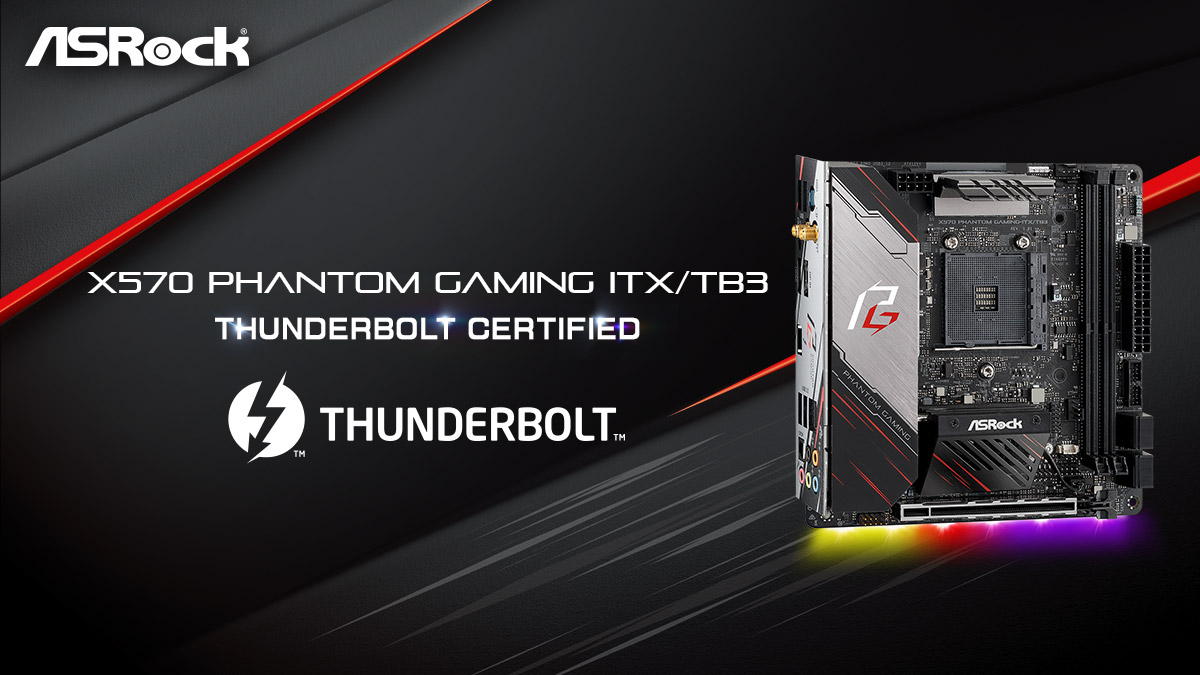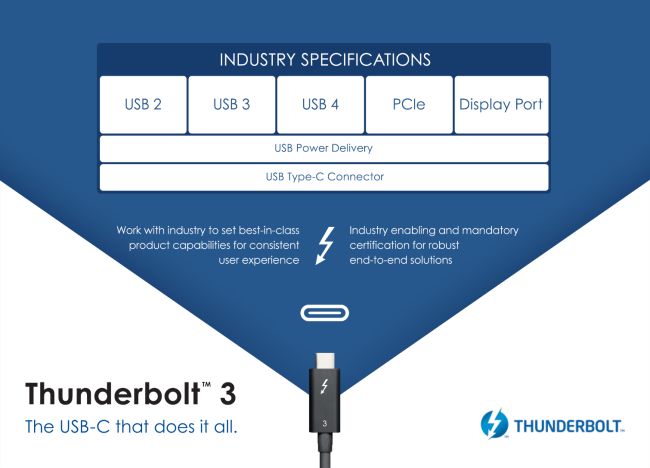Intel Finally Certified an AMD Thunderbolt Motherboard: Here's Why That Matters (Updated)
Update 2/6/2020 7pm PT: Clarified that Intel did not previously charge royalties for Thunderbolt. Instead, vendors weren't allowed to produce Thunderbolt controller silicon, which is now freely allowed.
Original Article:
There are plenty of AMD motherboards out there with Thunderbolt 3, but none of them have been certified by Intel until today. Today will go down as a special day in ASRock history, because now it's able to say that it's the first to have an Intel-certified Thunderbolt AMD board.
The motherboard in question is the X570 Phantom Gaming ITX/TB3, which is a small-form-factor Mini-ITX motherboard based on AMD's latest enthusiast X570 chipset. In our ASRock X570 Phantom Gaming-ITX/TB3 review in August, we gave the mobo our Editor's Choice award, meaning it was already a great motherboard. Now, it just has a new certification to boast about.

What makes this worth celebrating is that it took three generations of AMD Ryzen for Thunderbolt to finally reach AMD boards, and it took the better part of a year for one of those products to earn Intel certification.
In the past, Intel didn't allow vendors to produce Thunderbolt-compatible silicon. But in an effort to boost adoption, Intel abolished this practice in 2019 and handed the Thunderbolt 3 specifications over to the USB Implementers Forum (USB-IF). However, getting Intel certification still requires a one-time fee, the details of which remain undisclosed. It's unclear whether Thunderbolt certification will continue to be a thing after USB 4 is standardized in the market.
Thunderbolt was a proprietary Intel technology, and though it operates over a USB Type-C port, it is capable of far more than just carrying a USB signal. It can also handle power delivery, DisplayPort and PCIe. Thunderbolt 3, therefore, can carry a bandwidth of up to 40 Gbps, which is twice that of USB 3.2 and four times as fast as USB 3.1 connections. Since USB 4 uses the Thunderbolt 3 protocol, it basically is Thunderbolt 3, so USB 4 will be able to reach that speed too once it's implemented in devices.
Get Tom's Hardware's best news and in-depth reviews, straight to your inbox.
Thunderbolt's biggest party trick is its ability to daisy-chain, with Thunderbolt 3 specifically able to chain up to six devices together. Paired with this ability comes the benefit of one-cable docking, which is why we've seen more and more monitors (for recommendations, see our Best Gaming Monitors page) embed USB hubs and Ethernet, connecting to a laptop over a single cable and skipping the need for a power cable altogether.
With this much information and power being transferred over a single cable, it's helpful to know that ASRock's motherboard will work up to the standard that Intel expects it to.
Niels Broekhuijsen is a Contributing Writer for Tom's Hardware US. He reviews cases, water cooling and pc builds.
-
Soaptrail My Intel laptop connects to a docking station via thunderbolt and it is so buggy! I love how static electricity causes my two external monitors to go blank everytime i get up and come back to my desk.Reply -
TCA_ChinChin Now the rumor that Thunderbolt 3 is still Intel exclusive can finally be put to rest.Reply -
TechLurker You forgot the AsRock X570 Aqua. The first AM4 mobo to ever come with Thunderbolt capability. Linus himself was able to use it for his home PC setup.Reply
Then there's the older TR4 X399 Designare Ex from Gigabyte, which had a Thunderbolt header to connect to a TB Card. Though no one has ever mentioned if Gigabyte has enabled Thunderbolt capability on it since Intel finally made TB available to all. Last I recall, Level1Techs managed to get it working, but at the time, could not publicly share how. No one has tried ever since. -
Gillerer I don't think they forgot. This news item wasn't about "capability" but official certification; I don't think any of the boards you mention have that.Reply -
digitalgriffin I have dual port usb c thunderbolt on my dell docking station. If you breath on it wrong the best you can hope for is the docking station going to sleep and not locking up. But the only way you can get the docking station working again is to put the laptop to sleep and then restart it. Then you have a 50:50 chance it will restart properly.Reply
Basically its trash, even after 5 firmware updates. Everyone in the company HATES them. What's even worse is the small docking stations are even worse. -
TechLurker ReplyGillerer said:I don't think they forgot. This news item wasn't about "capability" but official certification; I don't think any of the boards you mention have that.
Not that I'm disagreeing or anything, but isn't certification mandatory before a company can even allow a mobo to use Thunderbolt? The story mentions that certification by Intel is still required for now.
If that's the case, the X570 Aqua has had the Intel Driver for its TB port available since its release, implying AsRock already paid for the Certification for the Aqua motherboards (and undoubtedly part of its high cost). Same would apply for the X570 ITX/TB3, assuming it also already has a Thunderbolt driver available.
On the other hand, the Designare was not permitted to allow use of a TB Card despite having a TB header. And either they didn't want to pay for Certification or just haven't bothered to do it, since their X399 Designare support doesn't have any kind of Intel Thunderbolt Driver available. The only person who got TB to work on the Threadripper Designare was L1Techs, and he couldn't share how he did it since it used proprietary code. -
hannibal When Intel did allow the use of thunderbolt there has been devices using it, but vertification is different thing.Reply -
Darkbreeze Reply
Not verification, "certification".hannibal said:When Intel did allow the use of thunderbolt there has been devices using it, but vertification is different thing. -
duddit21978 ReplySoaptrail said:My Intel laptop connects to a docking station via thunderbolt and it is so buggy! I love how static electricity causes my two external monitors to go blank everytime i get up and come back to my desk.
Ive found quality of cables really matters with he TB docks, after nothing but trouble I got a new cable and not a single issue has sprung up.... -
Rdslw Reply
its not but license cost so much that literally few boards did certify that way for AMD. I've seen I think 2 boards 750$ one and 1000$ limited one.TCA_ChinChin said:Now the rumor that Thunderbolt 3 is still Intel exclusive can finally be put to rest.

